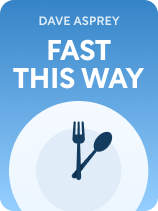

This article is an excerpt from the Shortform book guide to "Fast This Way" by Dave Asprey. Shortform has the world's best summaries and analyses of books you should be reading.
Like this article? Sign up for a free trial here.
What are the different types of intermittent fasting? How do you decide which type to choose?
Different types of intermittent fasting include time-restricted eating and alternate-day fasting, either fasting during certain times or on certain days. Learning about each option can help you decide what’s right for you.
Read on to discover common patterns for fasting, both time-restricted and alternate-day.
Decide Which Type of Fasting Works for You
There are different types of intermittent fasting you can try, each with its unique health benefits. If you’re new to fasting, start with the 16:8 Bulletproof intermittent fast. This involves fasting for 16 hours and eating during an eight-hour window, with the addition of Bulletproof Coffee. For example, after a night’s sleep, you could drink a cup of Bulletproof Coffee in the morning, eat lunch at noon (or later), eat dinner, and stop eating at around 8:00 p.m.
Other types of intermittent fasting include:
- The 5:2 fast: Eating normally for five days of the week and eating 500 to 600 calories on the other two days.
- One Meal a Day (OMAD): Fasting for 23 hours and only eating in a one-hour window.
- Alternate-day fast: Fasting every other day.
- Multi-day fasts: Fasting for four to five days or even longer—typically for people who are more experienced with fasting.
| Understanding the Intermittent Fasting Rhythms and Getting Started Experts suggest beginners start intermittent fasting with the 16:8 rhythm, but if you’re looking for a more detailed guide to follow, Fast. Feast. Repeat.’s Stephens outlines three plans you can choose from to map out your first month of intermittent fasting: Option 1 (Easy): Follow a 12:12 pattern (fasting for 12 hours and eating for 12) in Week One, 14:10 in Week Two, 16:8 in Week Three, and 18:6 in Week Four. Option 2 (Medium): Follow a 16:8 pattern in Week One, 17:7 in Week Two, 18:6 in Week Three, and 19:5 in Week Four. Option 3 (Hard): Follow an 18:6 pattern in Weeks One and Two, 19:5 in Week Three, and 20:4 in Week Four. Throughout these four weeks, Stephens encourages you to maintain your usual diet, since changing the foods you eat can make it harder for you to adjust to intermittent fasting. These different types of intermittent fasting all fall into one of two patterns of fasting—time-restricted eating and alternate-day fasting. According to Stephens, each offers unique benefits: Time-restricted eating (TRE): For this type of fasting, you divide each day into a fasting period and an eating period. This includes the 16:8 and OMAD fasts, as well as others like 18:6 (fasting for 18 hours and eating for six). According to Stephens, TRE is effective if you want to maintain weight. Alternate-day fasting (ADF): For this type of fasting, you alternate between days of fasting and days of eating normally. This includes the 5:2 fast and “True ADF,” which is fasting every other day. Stephens writes that ADF is more effective for intensive fat loss. She approves of eating a 500-calorie meal on fasting days but says going without food entirely can enhance fat burning. While multi-day fasts can be beneficial for more experienced practitioners, Stephens recommends you don’t try anything beyond a 72-hour fast without medical supervision because fasting can be hard on your body. She says extended fasts can often have negative consequences because when your body thinks it’s starving, it reduces your metabolism and triggers strong hunger signals. This can lead people to binge eat after a long fast, resulting in rapid weight gain. |

———End of Preview———
Like what you just read? Read the rest of the world's best book summary and analysis of Dave Asprey's "Fast This Way" at Shortform.
Here's what you'll find in our full Fast This Way summary:
- Why intermittent fasting is more than just a way to lose weight
- How our modern eating habits differ from our bodies' natural eating patterns
- An intermittent fasting method that makes it easier and more enjoyable






